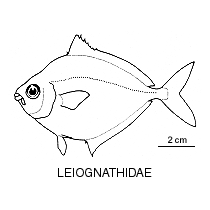- Classification
- ACTINOPTERYGII
- PERCIFORMES
- LEIOGNATHIDAE
Family LEIOGNATHIDAE
Small silvery compressed fishes with highly protrusible mouths.
All species are bioluminescent, with a colony of Photobacterium, bioluminescent bacteria, housed in a ring-like organ around the oesophagus. Males have larger light organs than females, presumably for courtship.
Ponyfishes also have a unique locking mechanism in both their dorsal and anal-fin spines. Most species are less than 20 cm in length.
They are widespread throughout tropical waters of the Indo-West Pacific where they live on soft bottoms in coastal marine and estuarine waters.
More Info
|
Family Taxonomy |
The Leiognathidae comprises about 50 species in 11 genera; 19 described species in 7 genera occur in Australian waters. |
|
Family Distribution |
Ponyfishes are found over soft bottoms in coastal marine and estuarine environments, often out over the continental shelf to depths of around 150 m. They are nocturnal, swimming in midwater at night, and demersal during the day. Leiognathids are distinctive in having a silvery body which is markedly compressed. |
|
Family Description |
Meristic features: Dorsal fin VII-IX, 15-17; Anal fin III, 13-15; Pectoral fin ; Pelvic fin I, 5; Caudal fin ; Vertebae 24 (10+14); Branchiostegal rays 5. Ponyfishes have a unique locking mechanism on some of their dorsal and anal-fin spines. |
|
Family Size |
Maximum length is 28 cm. |
|
Family Reproduction |
Many species are strongly sexually dimorphic, whereby the light organ and other associated features are larger in males than in females. This allows them to intensify the light produced during courtship. Males of some species also have transparent patches on the sides, pectoral, buccal, or gular regions that concentrates light on their bodies. |
|
Author |
Dianne J. Bray |
References
James, P.S.B.R. 1975. A systematic review of the fishes of the family Leiognathidae. Journal of the Marine Biological Association of India 17(1): 138-172 fig. 1 pls 1-3
James, P.S.B.R. 1985. Comparative osteology of the fishes of the family Leiognathidae. Pt 1: Osteology. Indian Journal of Fisheries 32(3): 309-357
James, P.S.B.R. 1985. Comparative osteology of the fishes of the family Leiognathidae. Pt 2: Relationships among the genera and the species. Indian Journal of Fisheries 32(4): 395-416
Jones, G. 1985. Revision of the Australian species of the fish family Leiognathidae. Australian Journal of Marine and Freshwater Research 36: 559-613 figs 1-19
Kimura, S., Yamashita, T. & Iwatsuki, Y. 2000. A new species, Gazza rhombea, from the Indo-West Pacific, with a redescription of G. achlamys Jordan & Starks, 1917 (Perciformes: Leiognathidae). Ichthyological Research 47(1): 1-12 figs 1-9
Mochizuki, K. & Hayashi, M. 1989. Revision of the leiognathid fishes of the genus Secutor, with two new species. Science Reports of the Yokosuka City Museum 37: 83-95 figs 1-7
Nelson, J.S. 2006. Fishes of the World. Hoboken, New Jersey : John Wiley & Sons, Inc. 601 pp.
Sparks, J.S. & Dunlap, P.V. 2004. A clade of non-sexually dimorphic ponyfishes (Teleostei, Perciformes, Leiognathidae) : phylogeny, taxonomy, and description of a new species. American Museum Novitates 3459: 1-21
Woodland, D.J., Premcharoen, S. & Cabanban, A.S. 2001. Leiognathidae. pp. 2792-2823 in Carpenter, K.E. & Niem, V.H. (eds). The Living Marine Resources of the Western Central Pacific. FAO Species Identification Guide for Fisheries Purposes. Rome : FAO Vol. 5 2791-3379 pp.
Yamashita, T., Kimura, S. & Iwatsuki, Y. 1998. Validity of the leiognathid fish, Gazza dentex (Valenciennes, 1835), with designation of a lectotype, and redescription of G. minuta Bloch, 1795. Ichthyological Research 45(3): 271-280























































